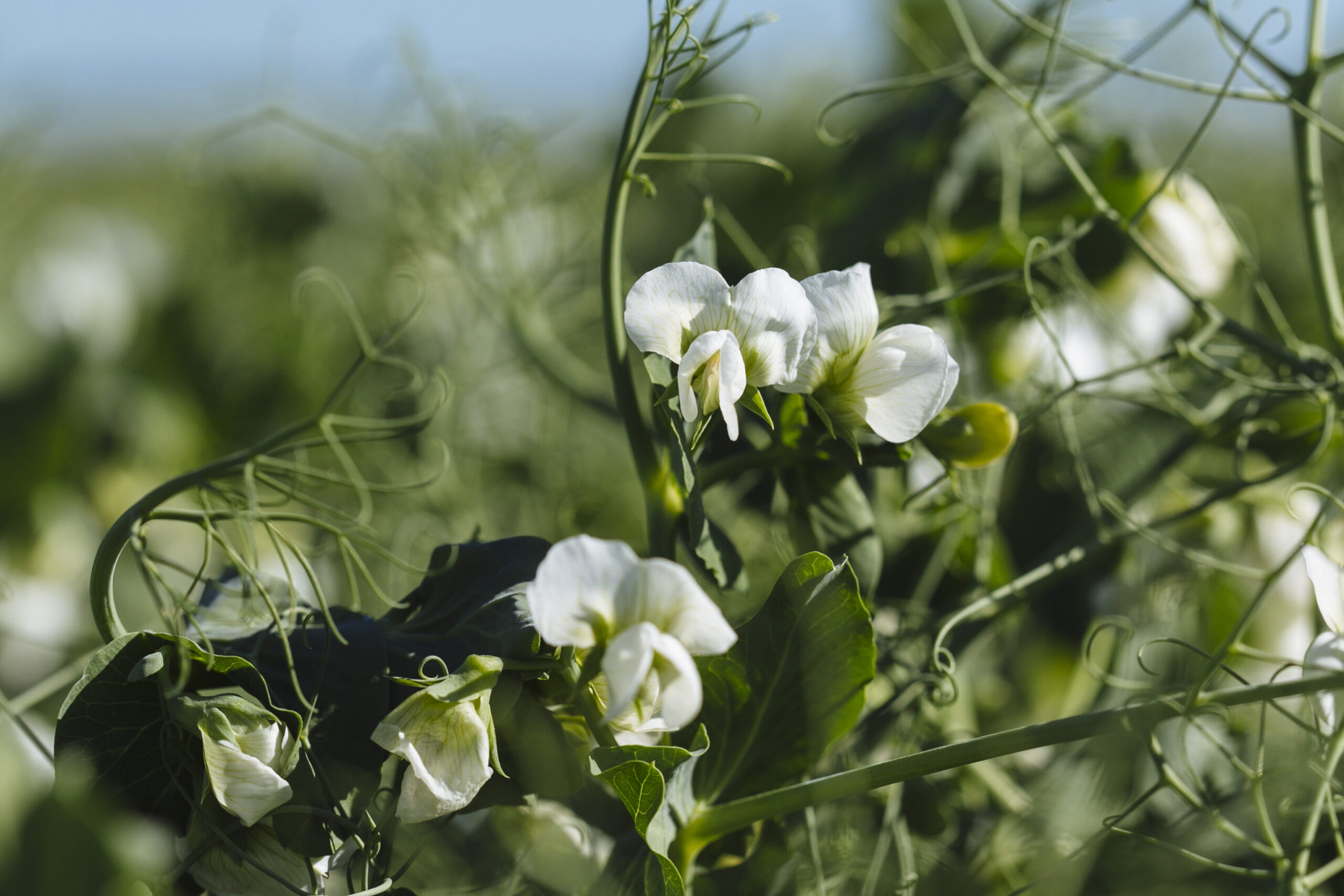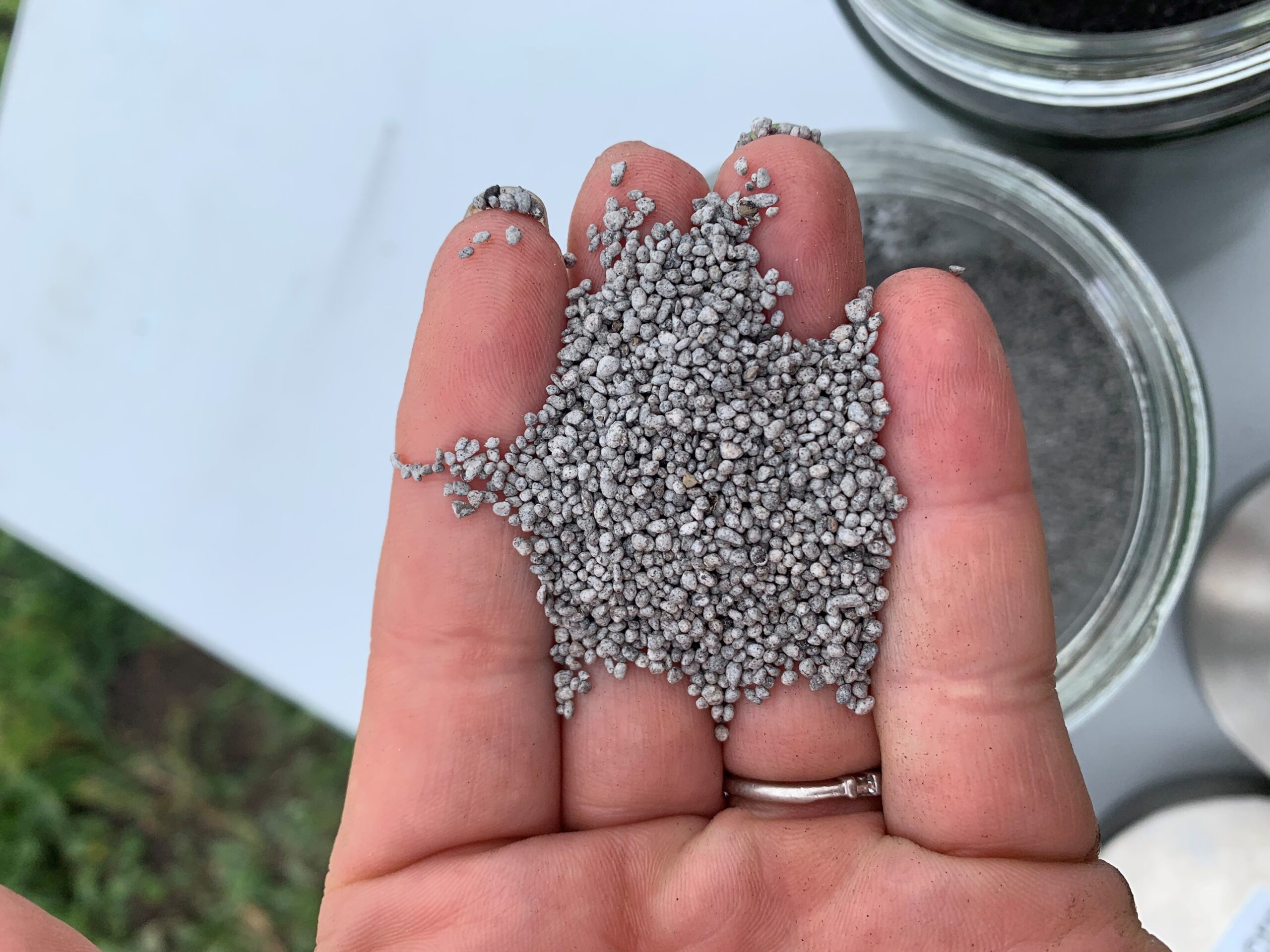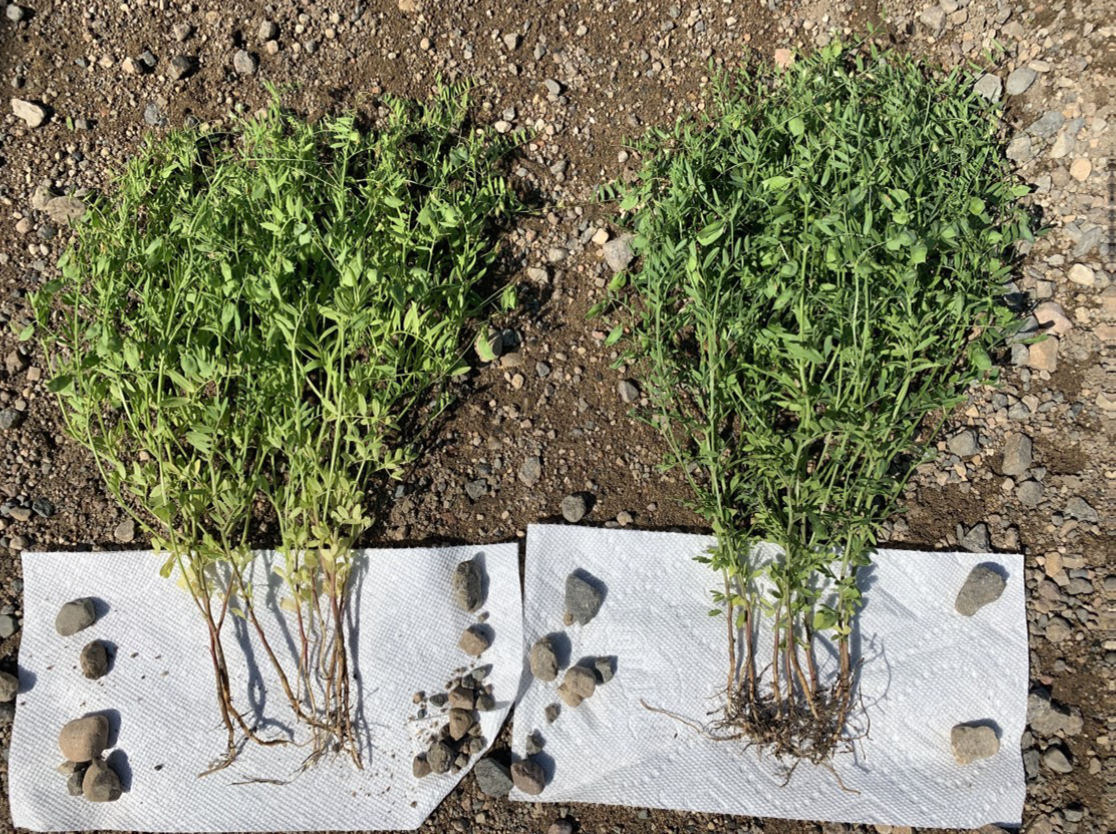Description & Adaptation
Peas are annual, cool-season pulse crops that perform well in cooler temperate ecozones. Because of this, they are well-adapted to our Western Canadian climate.
Since the plant’s growing point remains below the soil surface for some time after germination (hypogeal germination), peas are notably tolerant to frost and mechanical damage (ex, deer feeding) in early growth stages. They can thus be seeded relatively early in the spring.
The first genuine leaf is produced at the third node position, while the first and second nodes produce “scale leaves,” which are small, close to the stem, and may not even emerge from belowground. First true leaves consist of a pair of leaflets and a tendril in leafed pea varieties; in semi-leafless peas, tendrils replace the leaflets. The tendrils help the plants intertwine with one another, improving both standability and harvestability. Almost all Saskatchewan-grown pea varieties are semi-leafless.
Pea varieties grown in Saskatchewan are typically indeterminate, meaning they continue to grow and flower until a stress factor induces maturity. Peas usually start flowering between the 12th and 16th node stage. Pea flowers have separate male (stamen) and female (pistil) parts and undergo self-pollination before opening. Cross-pollination can occur through insects, but it is rare. Most pea varieties have white flowers, while some forage varieties can have purple flowers.
During the reproductive stage, pea pods develop and are fully elongated within seven to 10 days. Over 24–30 days, the seeds within the pods grow and mature. Physiological maturity occurs when the seeds are fully developed and their colour changes. At this point, seeds are at ~35% moisture. Fully formed pods are 4 to 10 cm long and 1 cm wide, containing 6 to 8 seeds. Seed sizes range from 150 to 280 grams per thousand kernels, depending on the variety and growing conditions. Bushel weight for dry peas is 60 pounds.
Peas grow best in clay loam-textured soils, characterized by dark brown, black, and even grey soil zones, but can also be grown in the brown soil zone. Peas prefer well-drained, moist soils due to their shallow root systems and do not tolerate saturated or saline soils well. Planting peas on cold, poorly drained soils favours the development of seedling diseases and root rots and should be avoided.
A low soil pH can inhibit nodulation, thereby reducing nitrogen fixation and plant growth. However, most Saskatchewan soils have a suitable pH range for pea growth, so this is typically a non-issue for Saskatchewan growers.
Peas grow best when daytime highs are between 13°C and 23°C. Peas can tolerate heat or drought stress during flowering, but yields may be reduced as a result. Flower abortion can occur at higher temperatures (over 25°C).
Related Resources
Varieties
Yellow and green cotyledon peas are most popular in Saskatchewan and are suitable for human consumption and livestock feed markets. These varieties have white flowers and are semi-leafless. Historically, yellow pea varieties have outyielded green varieties, but the gap has narrowed with the advent of modern green pea varieties.
Specialty varieties for use as forage or silage crops may be leafed or semi-leafless. Marrowfat peas are grown for niche snack food markets. They are blocky, very large-seeded, and. Purple-flowered varieties with coloured seed coats (maple and dun pea) are also produced in Saskatchewan.
Varieties with improved tolerance to Mycosphaerella/Ascochyta blight and Fusarium wilt are being developed. All recently released pea varieties have resistance to powdery mildew.
Varieties may also differ in their standability, lodging resistance, height, seed size, level of seed coat breakage, and relative maturity. Varieties with good lodging resistance improve harvestability and reduce soil or earth tagging, which occurs when soil adheres to the seed, potentially causing downgrading when the peas are sold. Adding the semi-leafless characteristic to new varieties has improved lodging resistance. Taller pea varieties do not necessarily have weaker straw strength and are more competitive against weeds.
Bleaching resistance is another important consideration when choosing green pea varieties. Rain and hot sunny days increase bleaching, especially near harvest.
Want to see how different varieties compare?
Visit the Interactive SaskSeed Guide for information on all pea varieties available to Saskatchewan producers.
Related Resources

Exciting Future Ahead for Pulse Breeding
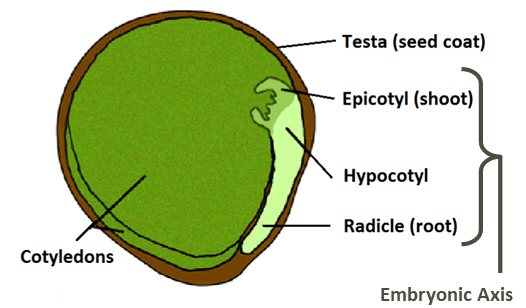
Understanding Protein in Pulses

Pulse Variety Hub
Designed to share the comprehensive, complete results of SPG’s regional variety trials in a format…
Seeding
The recommended target plant density for peas is 75–85 plants per square metre (7–9 per square foot) seeded at a depth of 3–8 cm (1.2–3.2 inches). Peas can be seeded as deep as four inches if surface moisture is low. Peas can be seeded when the minimum average soil temperature at seeding depth is 5°C. In Saskatchewan, seeding usually occurs from mid-April to mid-May.
Seed Quality
Seed quality is critical for stand establishment, health, and vigour. Seed quality encompasses genetic and mechanical purity, germination and vigour, as well as levels of seed-borne disease.
Seed purity is determined by the nature and amount of contaminants in the seed. Impurities include foreign crops, weed seeds, and inert material. These can adversely impact crop yield and quality and increase production costs.
Seed germination tests assess the ability of seeds to produce healthy plants under favourable growing conditions. These tests are conducted under controlled conditions that provide ideal moisture, temperature, and light for a prescribed period.
Seed vigour tests are conducted under more adverse conditions than germination tests. They evaluate how the seed germinates under less-than-ideal conditions and indicate the vigour of the seedlings. Vigour tests are not standardized, and conditions imposed upon the seed may vary from lab to lab.
Dry pea seeds (<14% seed moisture) are susceptible to mechanical damage during harvest, handling, storage, and seeding. All handling should be done as gently as possible. Even nearly invisible seed cracks can result in a reduction in germination.
Applying certain herbicides before harvest can also affect seed germination and/or vigour. Seed from fields treated with pre-harvest glyphosate should be avoided. Contamination from seed-borne diseases should be as low as possible. Table 1 summarizes guidelines for seed disease levels when considering a lot for seed.
Table 1. Guidelines For Tolerances of Seed-Borne Diseases in Pea Seed Intended For Planting
| Disease (Pathogen) | Tolerance & Factors Affecting the Level |
|---|---|
|
Ascochyta (Mycosphaerella pinodes, Ascochyta pinodella, Ascochyta pisi) |
Up to 10% Ascochyta infection should not significantly affect plant establishment and yield, as long as the seed has good germination, and spring conditions promote quick germination and good seedling vigour. Seed-to-seedling transmission of Ascochyta in pea under field conditions is considered low. In areas where pea production is common, the primary means of infection is air-borne spores from the overwintering stage of Mycosphaerella pinodes on pea residues. |
|
Seed Rots and Damping-off (Pythium sp. & Phytophthora sp.) |
These are soil-borne diseases and are not tested for at seed testing labs. Seed treatment in field peas may be beneficial when planting under cool, moist soil conditions or if using damaged or cracked seed. Seed Rots and Seedling Blights (Botrytis, Sclerotinia, Rhizoctonia, and Fusarium species) Sclerotinia, Rhizoctonia and Fusarium are primarily soil-borne. Botrytis and Fusarium are also often seed-borne and can be tested for at seed testing labs. Up to 10% infection (Sclerotinia + Botrytis) may be tolerable but will result in significant seedling blight if a seed treatment is not used. The importance of seed-borne Fusarium in seed rot and seeding blight in pulses is not known. Some labs will notify growers if greater than 5% Fusarium infection occurs. If present, add the Fusarium value to the Sclerotinia + Botrytis value above (not to exceed 10%). |
These guidelines are for informational purposes only and should be considered in conjunction with farming practices and the level of disease risk. Certified seed ensures high-quality seed in terms of purity, germination, and disease level.
Related Resources

Field Pea Seed Treatment Options
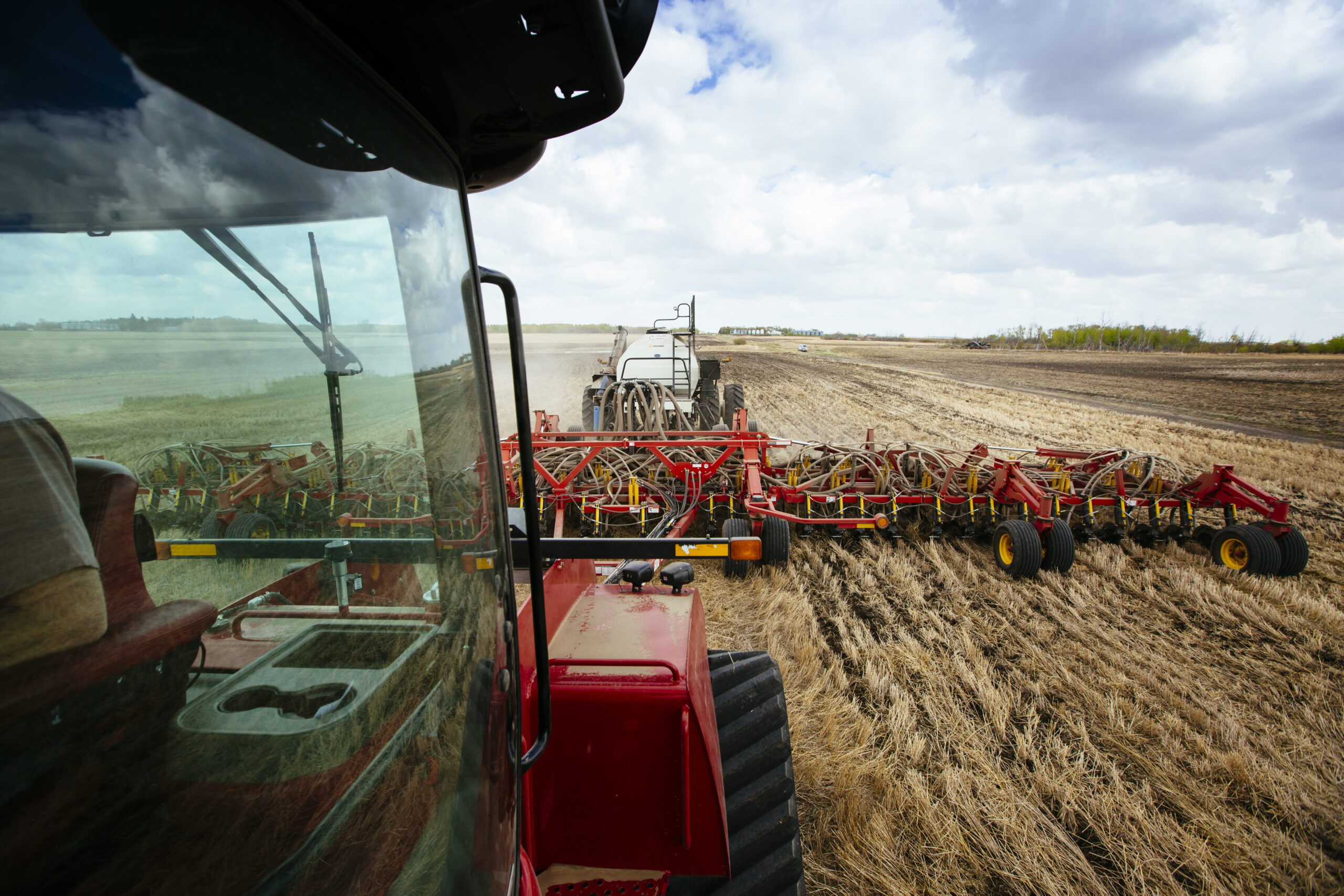
Calculating Seeding Rates
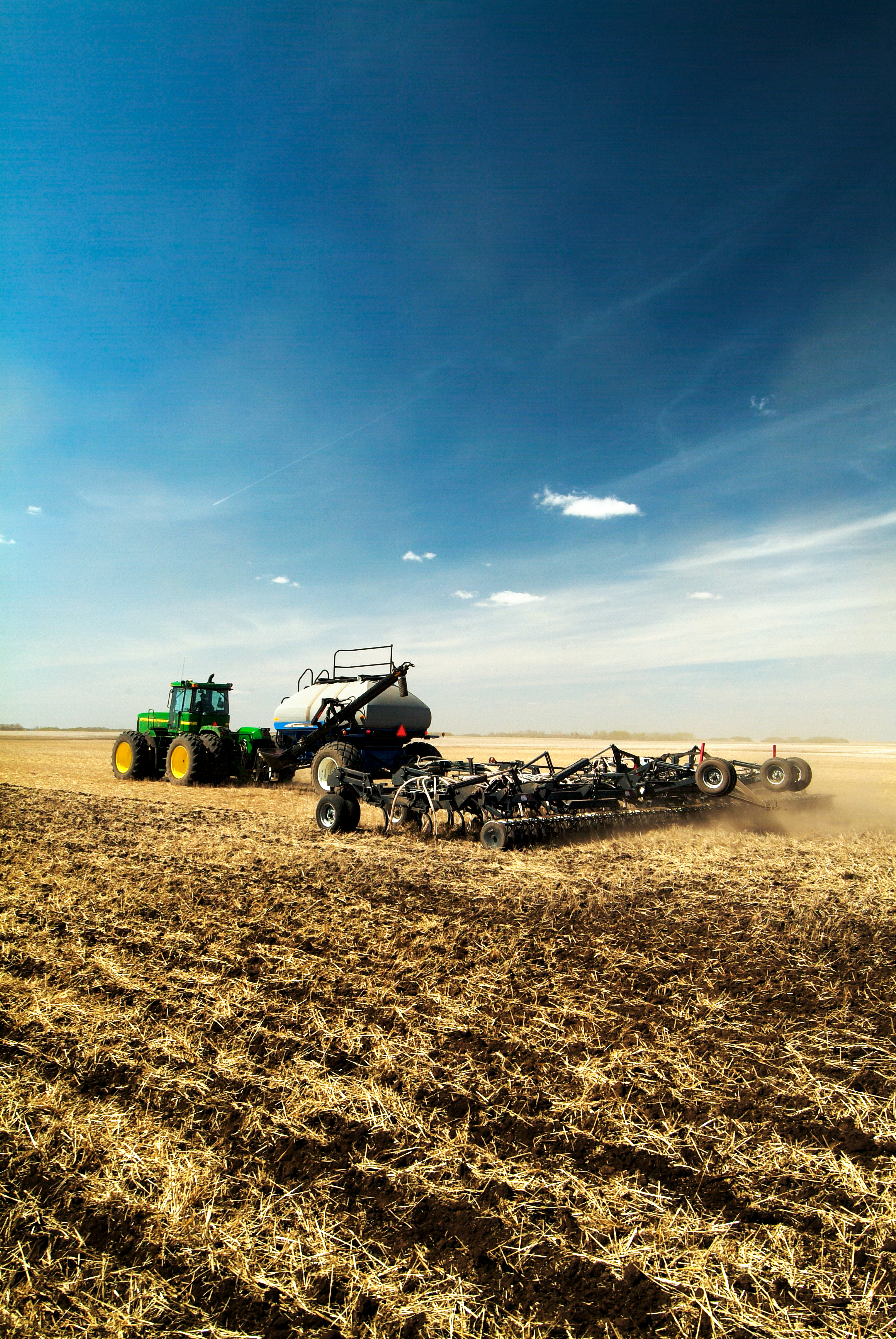
Seeding Tips For Pulse Crops
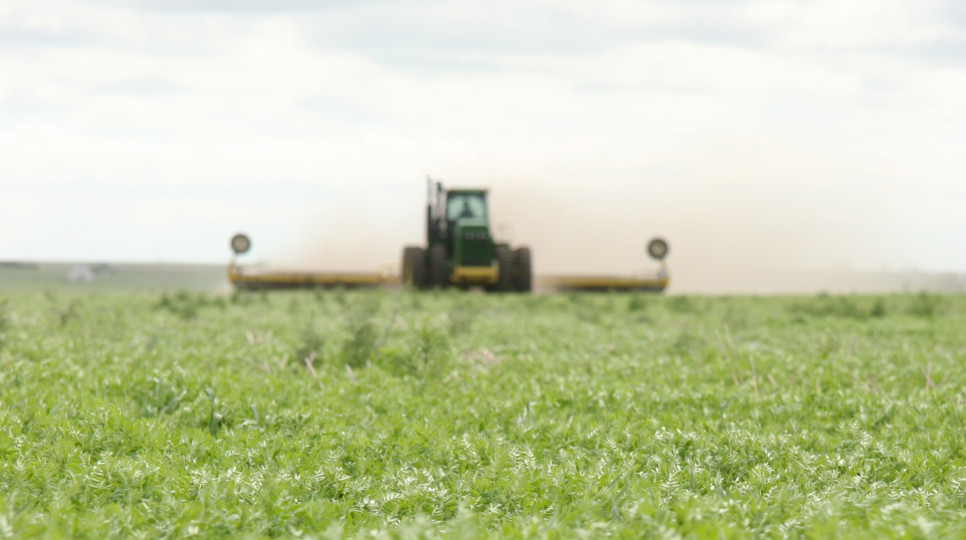
Tips for Rolling Your Pulse and Soybean Crops
Inoculation & Fertility
Peas inoculated with the proper Rhizobium (Rhizobium leguminosarum) strain can fix up to 80% of their required nitrogen through atmospheric nitrogen fixation.
Nitrogen fixation is a symbiotic interaction that benefits the Rhizobium and the plant. Rhizobium enters the plant’s root hairs and induces nodule formation, while the plant provides energy for the Rhizobium. The Rhizobium, in return, converts atmospheric nitrogen from the soil air surrounding the roots into a form that the plant can use. Maximum benefit is derived if soil moisture and temperature levels remain adequate and the supply of available soil nitrogen is low. High available soil nitrogen levels (over 55 kilograms of nitrogen per hectare, or 49 pounds of nitrogen per acre) inhibit nitrogen fixation since the pea plant preferentially uses the soil nitrogen rather than fixing atmospheric nitrogen.
Rhizobium leguminosarum strains will nodulate peas, faba beans, and lentils, but some strains may be more effective on specific crops or certain varieties. Once the proper inoculant is chosen, steps should be taken to ensure maximum rhizobia survivability. Rhizobium bacteria die if exposed to stress such as high temperature, drying winds, or direct sunlight. The inoculant must be stored in a cool, dark place before use and used before the expiry date. Following application of the inoculant, plant into moist soil as soon as possible.
Inoculants are sensitive to granular fertilizer. Banding fertilizer to the side and/or below the seed is recommended. Never mix inoculant with granular fertilizer. Inoculants are also sensitive to some seed-applied fungicides. Check the label of both the inoculant and seed treatment for compatibility. When using a combination of fungicide and inoculant, apply the fungicide to the seed first, allow it to dry, and apply the inoculant immediately before seeding.
Inoculants are available in liquid, powder/peat, and granular formulations.
- Granular inoculants are less affected by dry seedbeds and seed-applied fungicides than other inoculants. They are the least prone to exposure damage and allow for precise application rates when an additional seed cart compartment is available.
- Liquid inoculants offer convenience and better control of application rate. However, they are also more susceptible to damage before seeding from environmental extremes and seed treatments than other inoculant forms. Liquid formulations perform well if treated seed is planted immediately into a moist seedbed.
- Powder/peat formulations are more durable and less prone to desiccation and seed treatment damage than liquid formulations. The bacteria can still be killed by desiccation, so the same precautions should be taken with liquid. Some peat-based powder inoculants require the use of a sticker. Adhesion to the seed can be enhanced if the seed is slightly damp during inoculation.
All inoculant formulations will perform equally well if the inoculant is applied correctly and if environmental conditions are ideal. Under adverse conditions, the best-performing formulation should be granular, followed by peat, and then liquid.
Rhizobium bacteria can live in the soil for several years. However, survival rates vary, so it is recommended to inoculate each time peas are seeded. Western Canadian research indicates a significant yield response to inoculation of grain legumes in 30–50% of the cases. For this reason, most experienced pea producers use an inoculant on their pea crop every year.
Checking Nodulation
The best way to check for nodulation is to dig up a plant and gently remove the soil from the roots by rinsing with water. It may take three to four weeks after germination to evaluate nodulation. Nodules are easily identified as small, round growths on the roots of plants. If nitrogen fixation is active, the nodules will be pink or red inside. Lack of nodules indicates that rhizobia did not infect the plant. Green, cream, or brown coloured nodules indicate that the rhizobia are not fixing nitrogen.
Nitrogen fixation is synchronized with plant growth, supplying the crop with nitrogen during rapid vegetative growth. Nitrogen fixation declines as plants begin to form pods and develop seeds.
Soil testing is essential. If soil nitrogen levels are too high, nodulation and nitrogen fixation may be adversely affected. As the nitrogen supply from soil and fertilizer increases, the amount of nitrogen the plant fixes decreases. Nitrogen is necessary for high yields, but nitrogen fertilizer application is generally not required for peas. Peas can fix up to 80% of their nitrogen requirements, with the remaining 20% sourced from the soil, utilizing what is available during seeding, as well as what is mineralized during the growing season.
When the combined soil and fertilizer nitrogen levels reach 28–40 kg per hectare (kg/ha) or 25–35 pounds per acre (lb/ac), any additional nitrogen will delay the onset of nodules and reduce nodulation and nitrogen fixation. Combined soil and fertilizer nitrogen levels greater than 55 kg/ha (50 lb/ac) can prevent nodulation and nitrogen fixation.
Early plant growth may be poor in soils with nitrogen levels less than 11 kg/ha (10 lb/ac), and plants may appear yellow before the onset of active nitrogen fixation due to nitrogen deficiency. This early deficiency can be corrected by adding low levels (10–15 kg/ha, 9–13 lb/ac) of starter nitrogen at seeding. Although high levels of starter nitrogen may help the crop overcome a nitrogen deficiency during early crop growth stages, final seed yields may not increase. Monoammonium phosphate (MAP) (e.g., 12-51-0) can provide a small amount of starter nitrogen needed for early plant growth.
Phosphorus promotes the development of extensive root systems and vigorous seedlings. Encouraging vigorous root growth is crucial in promoting healthy nodule development, nitrogen fixation, and early, uniform maturity.
Peas have a relatively high requirement for phosphorus. A 50 bushel per acre (bu/ac) pea crop takes up 40–54 kg/ha (36–48 lb/ac) of phosphate, and 35–43 kg/ha (31–38 lb/ac) is removed from the field with the seed.
Peas grown in soils testing low in available phosphorus, or under cool, wet conditions, may respond positively to phosphate fertilizer, but dramatic yield responses are not always achieved. Even if seed yield increases are not achieved yearly, a pea crop may benefit from improved stress tolerance because of phosphorus application.
The maximum safe rate of actual phosphate applied with the seed is 17 kg/ha (15 lb/ac) in a 2.5 cm (1 in) spread and 15–18 cm (6–7 in) row spacing under good to excellent moisture conditions. Rates of seed-placed phosphate should be reduced if the seedbed has poor moisture conditions. Higher rates of phosphate fertilizer placed in the seed row with narrow openers, such as discs or knives, can damage the emerging seedling and reduce the stand. If higher phosphate rates are required, consider banding the fertilizer away from the seed (sideband or to the side and below). If sidebanding, sideband all the phosphate fertilizer, especially when using narrow openers.
Peas have a high demand for potassium, requiring approximately 135–165 kg/ha (123–150 lb/ac) K2O for a 50-bu/ac crop. This works out to just over 1 kg/ha (0.9 lb/ac) for every bushel of grain produced. Use a soil test to determine whether additional potassium is required. Seed-placing potassium may cause seedling damage. A wider opener may allow for slightly higher safe seed-placed rates, as is the case with phosphate. The sum of seed-placed potassium (K2O) plus phosphate fertilizers must not exceed the recommended safe rate of phosphate mentioned previously (17 kg/ha or 15 lb/ac).
Most potassium taken up remains in plant residue and is not removed with the grain. Most Saskatchewan soils are sufficient in potassium. However, deficiencies may exist based on region and farming practices. Fertility requirements should be determined based on soil test results.
Sulphur is required in a relatively significant amount. A 40 bu/ac pea crop requires about the same amount of sulphur as a 40 bu/ac wheat crop: approximately 9–11 kg/ha (8–10 lb/ac). Soils testing low in available sulphur should have this deficiency corrected by side-banding, mid-row banding, or broadcasting ammonium sulphate, which contains sulphur in a plant-available form.
Micronutrient deficiencies for pea production have not been identified as a widespread problem in Western Canada. If a micronutrient deficiency is suspected, it is advisable to analyze soil and plant samples within the suspect area and compare the analysis to soil and plant samples collected from a non-affected area of the same field. If the study confirms a micronutrient deficiency at a relatively early growth stage, a foliar application of the appropriate micronutrient fertilizer may correct the problem.
